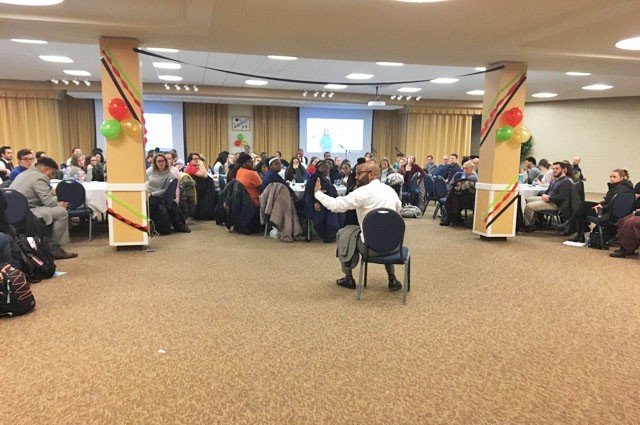‘Hip-hop education’ looks at urban school systems

GVL / Emily Frye Chris Emdin speaks to GVSU students on Monday January 29, 2018.
Feb 1, 2018
Christopher Emdin, a visiting professor from Columbia University, shared his passion for education and equity with an audience at Grand Valley State University on Monday, Jan. 29.
Emdin spoke at the “hip-hop education” event in the Kirkhof Center Grand River Room, an event sponsored by the GVSU Black Student Union. The topic was designed to challenge the perceived “unteachable” nature of students of color.
Emdin spoke with GVSU students about continuing in today’s education system what Martin Luther King Jr. had begun in his 1950s movement. Emdin told the audience that fighting social injustice does not look like students refusing to leave a counter or marching across a bridge but instead fighting in subtle ways, the first being contemporary education.
“The civil rights issue of our time is what happens in education,” Emdin said.
Emdin brought to light the two kinds of personalities students choose when they enter a room full of people. In one theory from his new book, “For White Folks Who Teach in the Hood … and the Rest of Y’all Too: Reality Pedagogy and Urban Education,” he proposed that students have their “ratchet” self, which expresses an authentic representation of themselves. They also have their academic self, which works to conform to the mold that education and other students set for them in order to fit in.
Emdin said society has constructed a false narrative that “ratchet-ness” is inherently anti-intellectual or anti-academic. Yet, Emdin argues that if education is going to change, new academic spaces need to be built where students can be as “ratchet” and academic as they desire.
“I want students to understand that for some students, they can be themselves and still learn, and we shouldn’t let people’s perceptions of them inhibit them from being academically successful,” Emdin said. “For other students, I want them to see the humanity of their peers, to recognize even though they may have opportunities to be able to connect easily to school that some may not, and to give them humanity.
“I want everybody to go and try to focus on education, no matter what field you are in, no matter if you are an education major or not. To understand that will really help us to fulfill MLK’s legacy, and we all have a responsibility to go into schools.”
Emdin stressed the oppression that society has placed on African-American students by not allowing them to be themselves and forcing them to conform to what is considered normal. As an example, he referenced a recent H&M advertisement with a young African-American boy wearing a sweatshirt that said “coolest monkey in the jungle,” while the sweatshirt a young white boy wore said “jungle expert.”
Emdin used this scenario to express the offense African-Americans took to the reference and also how they are demonized by the word “cool.” He described the word “cool” as students’ middle ground between being themselves and conforming to others; according to Emdin, students of color do not seem to be accepted until white students have validated them. Through these examples, Emdin aimed to reveal the difficulties people of color face in their everyday lives and offered a tool for healing.
“Healing comes from unapologetic representation of self,” Emdin said. “The very things we’ve been told to stay away from are actually the things we have to interrogate, work with and learn from for us to be able to actualize MLK’s dream.”
Emdin’s discussion also raised the importance of students’ willingness to learn in schools, acknowledging the reality of students’ need for freedom in order to learn well, whether they are in private, public or charter schools.
This need for freedom and willingness to learn circles back to students’ comfort in expressing themselves outside of their neighborhoods.
“You can’t connect with young folks until you are willing to enter into their world,” Emdin said.
Emdin concluded the presentation to a standing ovation from faculty and students.
“It was really interesting; (I liked) his energy and passion,” said GVSU student Baylee Arendsen. “(I was interested in) the way (I plan to) implement (these approaches) in volunteering in the classroom and in tutoring this semester, not only for students in minorities but to see how (people accept) different approaches.”























